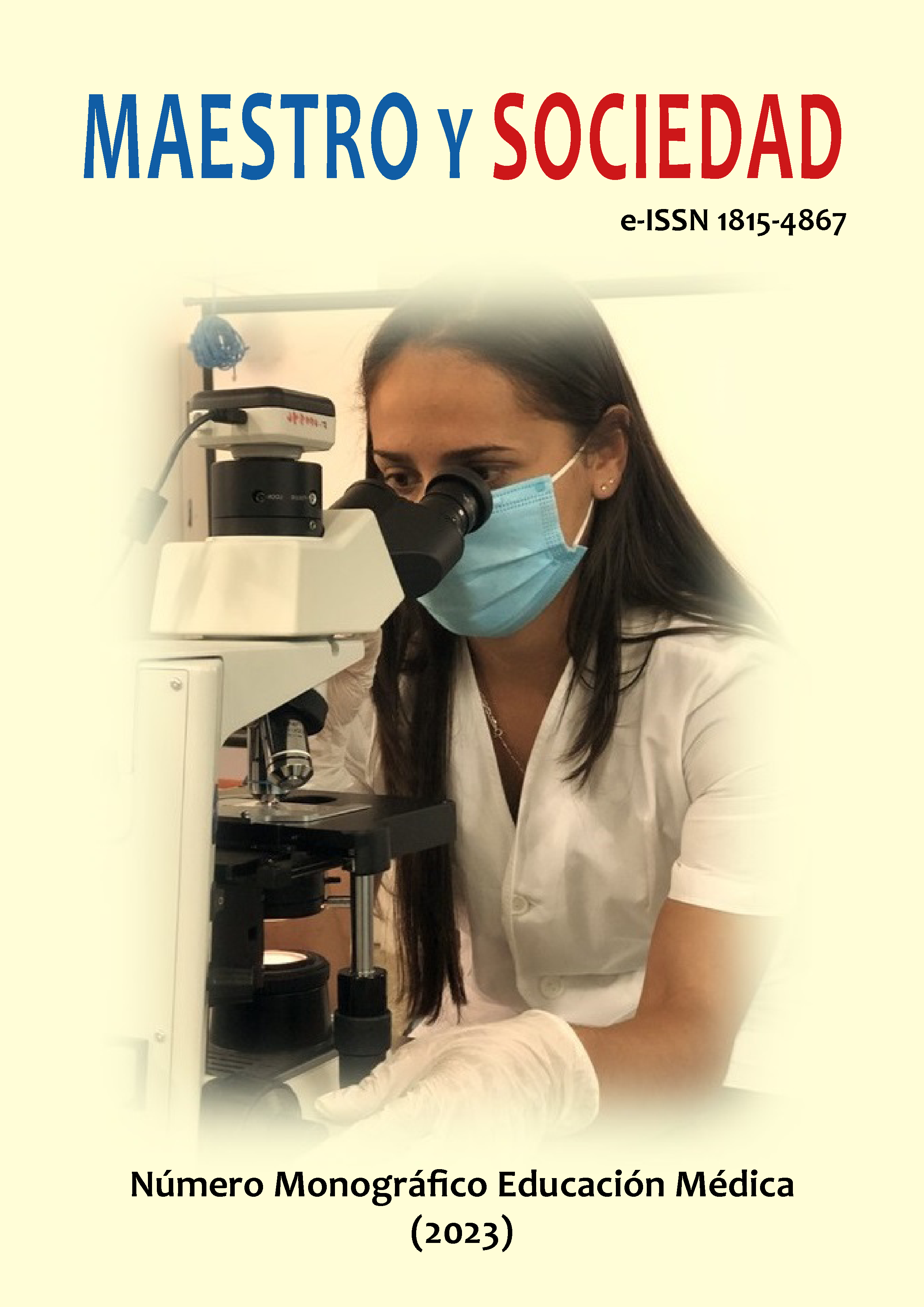Physiopathological characteristics of hypertensive patients exposed to stress testing seen in outpatient clinics
Keywords:
hypertensive patients, pathophysiological characteristics, stress testAbstract
Introduction: The main importance of studying blood pressure during exercise lies in its diagnostic potential, not only
of HBP but also as a reflection of other diseases that can generate alterations in hemodynamics. Objective: Describe the
pathophysiological characteristics of hypertensive patients exposed to stress testing. Materials and Methods: A retrospective
cross-sectional descriptive study was carried out whose universe was made up of 76 patients between 18 - 60 years old treated
in the outpatient clinic of the Saturnino Lora Hospital. The data was obtained from the Clinical Records. The variables were
studied: age, sex, weight, hypertensive response to effort and comorbidities. Descriptive statistics (absolute and relative
frequency) were used to process the information. Results: There was a predominance of the age group of 33 - 47 years,
represented by 37%, followed by the age group 48 - 62 for 32.9% where there were 14 women, with respect to the total
number of patients in that group (24 ) and the male sex stood out, with 47 patients (64.4%). Discussion: Obesity can cause
or promote the appearance of atrial fibrillation. In a meta-analysis that included 16 studies with 123,000 patients, which
evaluated the impact of obesity on atrial fibrillation, it was shown that obese patients have a 50.0% greater risk of suffering from it, and this increases as the risk of atrial fibrillation increases. the BMI. Conclusions: Systolic blood pressure initially rises
with effort as a result of the increase in cardiac output parallel to the increase in load above established physiological values. As
age increased, the number of patients with moderate hypertensive response to exercise increased in the individuals studied.
References
Amaya C.R, Sandoval J.A. “Principales factores de riesgo cardiovascular asociados a la incidencia de Infarto Agudo de miocardio en el área de Medicina del Hospital Nacional San Juan de Dios de Santa Ana de enero a diciembre de 2016” [Tesis para optar al título de Especialista en Medicina Interna]. El Salvador: Universidad de El Salvador; 2017.
American Diabetes Association. (2018). Cardiovascular disease and risk management: Standards of Medical Care in Diabetes-2018. Diabetes Care; 41(sup 1): S86-S104.
Benet M, Cabrera RM, Coll Y, Curbelo Y, Leon ML, Diez E, et al. La hiperreactividad cardiovascular: un nuevo factor asociado al síndrome metabólico. Rev. Finlay [Internet]. 2011; 1:17-25. http://revfinlay.sld.cu/index.php/finlay/article/view/25/1175
Cabrera I, Izaguirre G. Respuesta cardiovascular durante el ejercicio físico en normotensos y prehipertensos. Rev Cub Invest Biomédicas [Internet]. 2008 [citado 2022 sep. 20];27: [aprox. 9 p.]. http://scielo.sld.cu/pdf/ibi/v27n1/ibi03108.pdf
Cabrera, I. y Izaguirre, G. (2018). Respuesta cardiovascular durante el ejercicio físico en normotensos y prehipertensos. Rev Cub Invest Bioméd, 27(1). http://scielo.sld.cu/scielo.php?script=sci_arttext&pid=S0864-03002008000100003&lng=es
Caicoya M. Historia de la hipertensión. [Sitio en Internet]. 2012 [citado 2022 ene 20]. https://www.informacion.es/vida-y-estilo/salud/expertos/2012/06/30/historia-hipertension-6783427.html
Consenso Argentino de Prueba Ergométrica Graduada (Versión resumida). Rev Argentina de Cardiología; 78(1). https://www.redalyc.org/pdf/3053/305326908017.pdf
Franco MR, Sainz B, Ramos B y Frías JA. Caracterización de pacientes con infarto agudo de miocardio con elevación del segmento ST. Rev Cub Cardiol Cir Cardiovasc. 2015 [citado 2022 oct 31]; 21(1): pp. 16-23. https://www.medigraphic.com/pdfs/cubcar/ccc-2015/ccc151d.pdf
García A., Lozano JE, Álamo R, Vega T; Workgroup of the RECCyL Study. Factors associated with control of hypertension in the cohort from the study of Cardiovascular Disease Risk in Castilla y León (RECCyL). Hipertens Riesgo Vasc. 2015 Apr-Jun; 32(2):48-55).
Guía de la Sociedad Argentina de Hipertensión para el diagnóstico, estudio, tratamiento y seguimiento de la Hipertensión Arterial. Sociedad Argentina de Hipertensión Arterial. [Internet] 2017. http://www.saha.org.ar/pdf/GUIA_SAHA_VERSION_COMPLETA.pdf
López-Jiménez F. y Cortés-Bergoderi M. Obesidad y corazón. Rev Esp Cardiol. 2011 [citado 2022 sep. 15]; 64(2): 140–149. http://www.revespcardiol.org/?ref=707257951
Komaroff, M. For researchers on obesity: Historical review of extra body weight definitions. Journal of obesity. 2016; 24: 1- 9.
Mahajan, R. et al. Electrophysiological, electroanatomical, and structural remodeling of the atria as consequences of sustained obesity. J AM Coll Cardiol 2015; 66: 1-11.
Mancia G, Fagard R, Narkiewicz K, Redon J, Zanchetti A, Bo M, et al European Society of Hypertension-European Society of Cardiology guidelines for the management of arterial hypertension. J Hypertens. 2013 [citado: 2022 oct 01]; 21(6):1011-53.
Nogara R. y Martínez C. Respuesta de la presión arterial al ejercicio en pacientes con hipertensión arterial. Escuela Universitaria de Tecnología Médica. https://www.colibri.udelar.edu.uy/jspui/bitstream/20.500.12008/18436/1/MGEUTM_Nogara_Martínez_2018.pdf.pdf
Noya, M. E. y Moya, N. L. (2017). Roca Goderich Temas de Medicina Interna. Editorial Ciencias Médicas.
Organización Panamericana de la Salud (OPS). (2016). Prevención de las enfermedades cardiovasculares. Directrices para la evaluación y el manejo del riesgo cardiovascular. OPS. http://www.paho.org/hq/index.php?option=com_docman&task=doc_ view&gid=13815&Itemid
Polo-Portes, C.E.; Del Castillo-Campos, M.J.; Ramos-Álvarez, J.J. y Lara-Hernández, M.T. Monitorización de la presión arterial en esfuerzo. ¿Brazo dominante, no dominante o ambos? / Monitoring of the Arterial Pressure in Effort. Dominant, Not Dominant Arm or Both? Revista Internacional de Medicina y Ciencias de la Actividad Física y el Deporte. 2017; 17 (65), 63-72.
Poirier P, Alper MA, Fleisher LA, Thompson PD, Sugerman HJ, Burke LE, et al. Cardiovascular evaluation and management of severely obese patients undergoing surgery: science advisory from the American Heart Association. Circulation. 2019; 110:66-75.
Salazar P.M, Rotta A, Costa F. O. Hipertensión en el adulto mayor. Rev Med Hered. 2016; 27: 60-66. http://www.scielo.org.pe/pdf/rmh/v27n1/a10v27n1.pdf
Santana TN, Rodríguez R, Rivero T, y del Águila A. Respuesta hipertensiva al esfuerzo en pacientes prehipertensos. AMC, 11(1). http://scielo.sld.cu/scielo.php?script=sci_arttext&pid=S1025-02552007000100004
Valdés A, Rivas EE, Antuña T, y Echevarría L. Utilidad de la Ergoespirometría en el diagnóstico y evaluación de las enfermedades cardiovasculares. Rev. cuba. cardiol. cir. cardiovasc, 22(1). http://www.revcardiologia.sld.cu/index.php/revcardiologia/article/view/631
Published
How to Cite
Issue
Section
License
Copyright (c) 2023 Yarlin Rodríguez Rabel, Odalis Querts Méndez, Maidilis Beltrán Moret, Lianne Alicia Chang Arañó

This work is licensed under a Creative Commons Attribution-NonCommercial-NoDerivatives 4.0 International License.
This journal provides immediate open access to its content, based on the principle that offering the public free access to research helps a greater global exchange of knowledge. Each author is responsible for the content of each of their articles.



























 Universidad de Oriente
Universidad de Oriente 